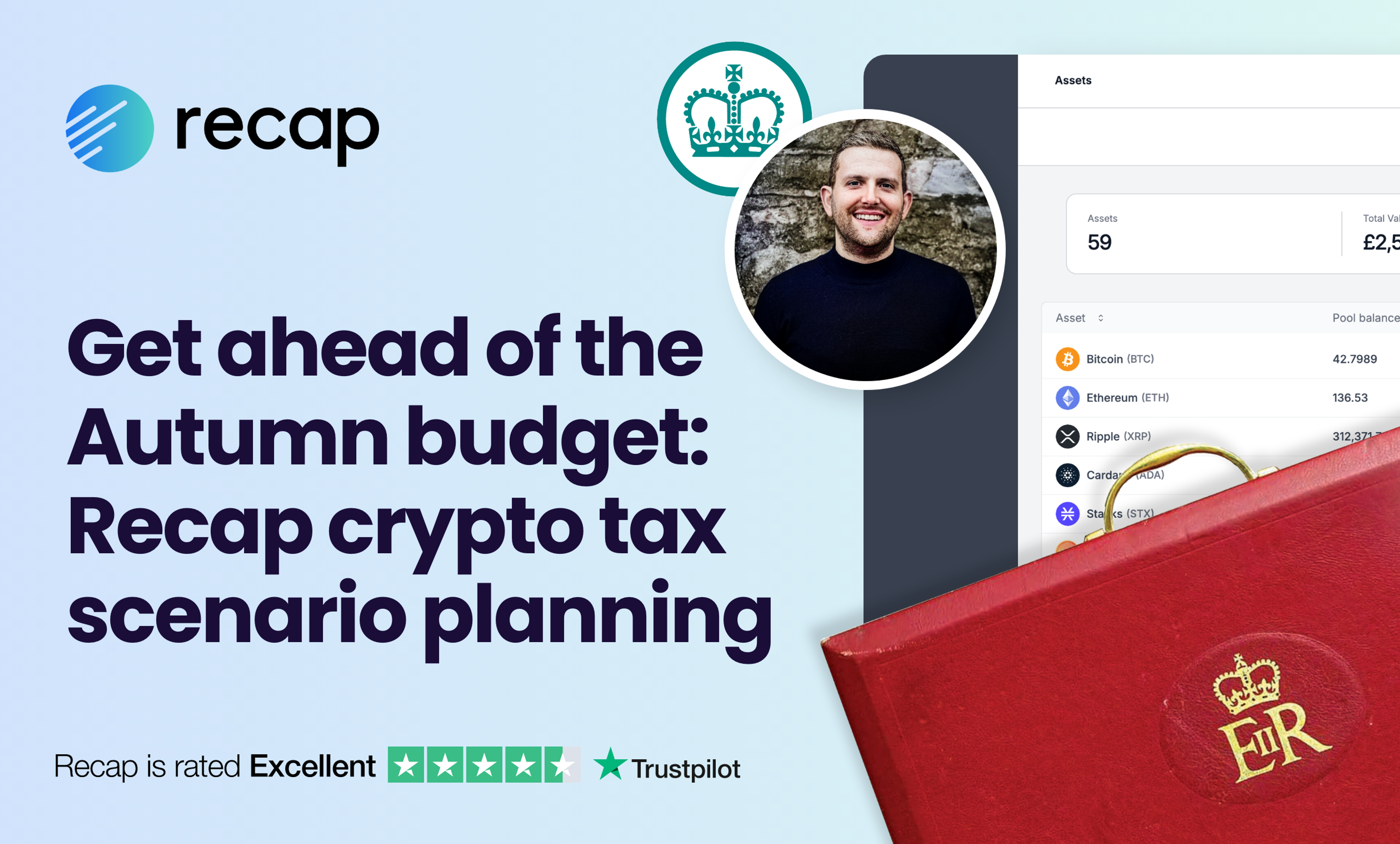
As the UK Autumn Budget 2024 approaches, crypto investors are bracing for potential changes to capital gains tax (CGT) that could significantly impact their financial strategies. Watch this video, where I explore how Recap can help you run tax scenarios, allowing you to estimate the implications of selling your crypto before or after the budget.
Key time stamps and overview
0:00: Introduction
The media are predicting a capital gains tax rise as the UK Autumn Budget gets closer so crypto investors are considering selling their crypto.
0:41: New asset page
Recap's new asset page shows all of your assets and your pool cost and unrealised capital gain or loss.
1:29: Activity screen and valuations
In Recap's activity screen you can understand how transactions have contributed to the cost of your asset's section 104 pool. You can also create transactions to estimate the tax impact of disposals.
2:19: Modeling future transactions
Create a transaction to see how sales and acquisitions of your assets will impact your tax positon.
Transcript
0:01 The 30th of October is approaching very quickly, and if you didn't know already, it's UK Autumn Budget Day.
0:09 The media are reporting that there is going to be a capital gains tax rise, and you might be asking yourself the question of, how do I stay ahead?
0:18 So I want to show you a few capabilities Recap has for you to plan your finances.
0:26 Now, I am not a tax advisor, I am not an accountant, I am not authorised to give tax advice. What I can show you are the tools within recap for you to create your own scenarios and your own tax strategies.
0:40 So, the first thing that I want to show you is our new asset page. This page has been developed specifically for the UK market.
0:49 We are a UK-first crypto tax calculator. Here we show you the breakdown of all of the assets in your portfolio, and we show you the acquisition cost - so how much did it cost for you to acquire that asset overall, and it's market value today.
1:06 We can see here, that this customer acquired a bitcoin for £550, and today it's worth about £52,667, and therefore they have an unrealised gain of £52,117.
1:27 If we go to the activity screen, you can see the history of how we've derived, those valuations.
1:37 So you can see the customer has put £550 onto an exchange, they then created a trade to buy a bitcoin with that £550, and if we go into the tax tab, and the acquisition, we can see that one Bitcoin was added into the customer's Section 104 pool with a value of £550 against it.
1:56 In Recap you can create future transactions so you can estimate the tax consequences.
2:12 For example, this customer might want to sell one Bitcoin, prior to the budget, you can come in here and you can model that.
2:22 So if we click Add Transaction and go to Trade Sell. Put in here the 29th of October, I want to sell one Bitcoin.
2:35 I think a Bitcoin is going to be worth £52,000 on the 29th of October. You can see immediately that transaction has been created in Recap.
2:45 If we hit the Tax tab, we can see that that's going to generate a disposal and this customer is going to realise a capital gain of £51,450.
2:52 It might be that this customer then wants to play out the scenario of, well, what happens if I buy that back after the budget?
3:03 Well, again, you can put that transaction into Recap. You'd say Trade Buy. Let's say the 2nd of November, when the dust has settled, this customer can come in here, create a buy transaction of Bitcoin. They think it's going to be worth, $52,000. Because the customer's buying this back within a 30-day window, they might want to see the potential implications of their tax position to understand the bed-and-breakfast rules.
3:34 So, I'm hovering on the previous trade where I sold my Bitcoin. If you remember, we had a disposal.
3:41 Well, that disposal no longer exists because we triggered the matching rules when we bought that asset back. So, by selling the asset and then buying it back within 30 days, they actually haven't realised a capital gain in this scenario.
3:59 So, I'm just giving you an example of how you might want to put in some transactions, so you can model out potential strategies, to get on top of your tax position.
4:11 If we go back to the asset screen, this is going to update in real time. I've still got an unrealised gain.
4:22 Feel free to, to try Recap out to work out your own tax scenario ahead of the budget. Thanks a lot for your time.
